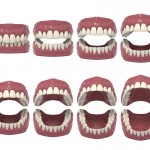
The increasing availability and use of computer-aided design and computer-aided manufacturing (CAD-CAM) has impacted on clinical and dental laboratory procedures. This has led to the use of CAD-CAM systems for the design and construction of both partial and complete denture construction.
The aim of this review was to compare the clinical outcomes of complete denture fabrication with CAD-CAM technology and conventional techniques.
Methods
Searches were conducted in the Cochrane Library, Embase, Medline/PubMed, SciELO and Web of Science databases. Clinical studies involving scanning (intraoral or laboratory), planning, and printing or milling of CDs with the CAD-CAM technology with conventional dentures as a comparison and published in English were considered. Two reviewers selected studies, extracted data and assessed risk of bias and a narrative synthesis presented.
Results
- 6 studies involving a total of 182 patients were included.
- 2 studies assessed retention, 2 time and cost, one considered tissue surface adaptation and 1 patient experience and satisfaction.
- A number of CD-manufacturing techniques were reported (pack and press, injection moulding as traditional processes, milling and digital light processing as digital processes).
- The studies reported that digitally manufactured complete dentures: –
- Showed better retention without denture adhesives than that of conventional complete dentures with or without denture adhesives.
- were better adapted to tissue surfaces,
- required less clinical time,
- were lower in cost, and
- provided better experience and satisfaction to patients.
Conclusions
The authors concluded: –
Rehabilitation with digitally manufactured dentures offers higher retention than CDs manufactured by conventional techniques.
The clinical time and overall cost of digital dentures were lower than those for conventional CDs.
The CAD-CAM CDs demonstrated better adaptation than conventional CDs, improving patient experience and satisfaction.
Comments
The authors have searched a good range of databases although restricting inclusion to studies published in English may have excluded some relevant studies a point noted by the authors. Only a small number of studies were identified, and these were small with only one studies including more than 21 patients. None of the included studies were randomised controlled studies and three of them involved the same group of authors. So, while the conclusions of the review sound promising the quality of the available evidence is limited and very weak and short term. High quality well conducted and reported randomised controlled trials of appropriate size with longer follow-up periods are needed to clarify the future use of CAD-CAM for complete denture fabrication.
Links
Primary Paper
Chappuis Chocano AP, Venante HS, Bringel da Costa RM, Pordeus MD, Santiago Junior JF, Porto VC. Evaluation of the clinical performance of dentures manufactured by computer-aided technology and conventional techniques: A systematic review. J Prosthet Dent. 2021 Jul 28:S0022-3913(21)00346-2. doi: 10.1016/j.prosdent.2021.06.029. Epub ahead of print. PMID: 34332774.
Other references
Dental Elf – 14th Oct 2020
Dental Elf – 17th Jun 2017
